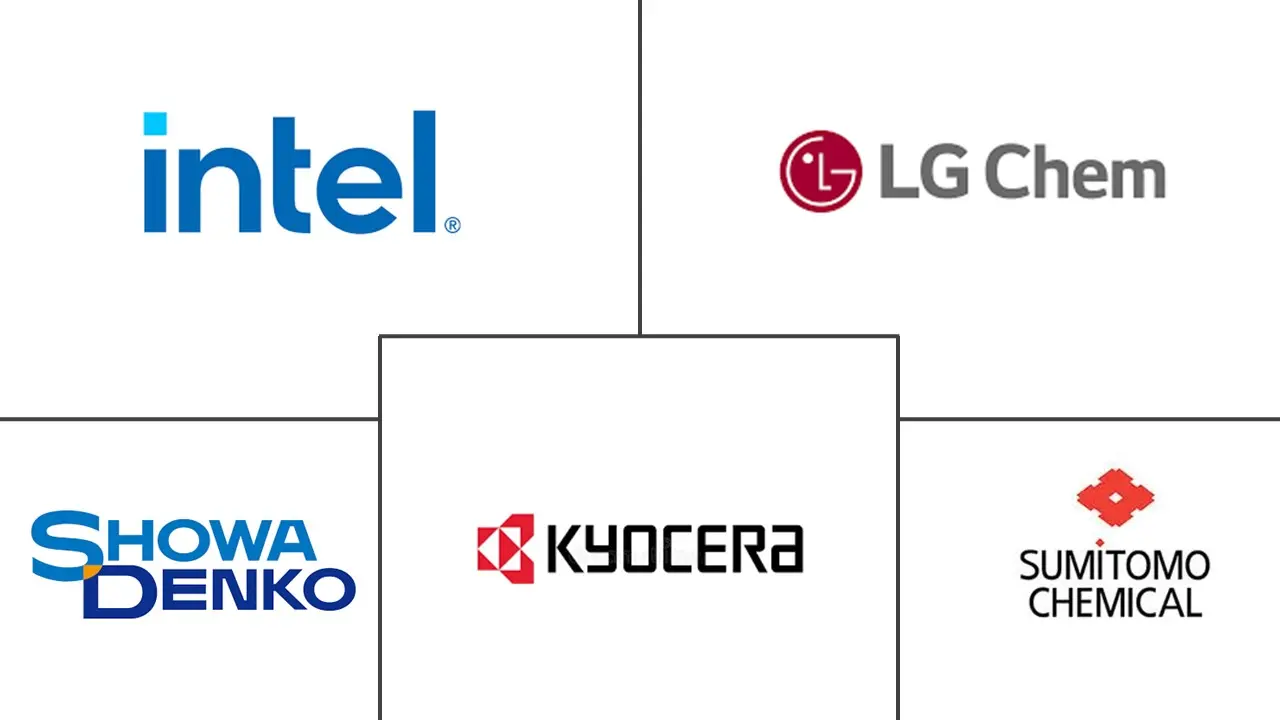APAC Semiconductor Materials Market Size
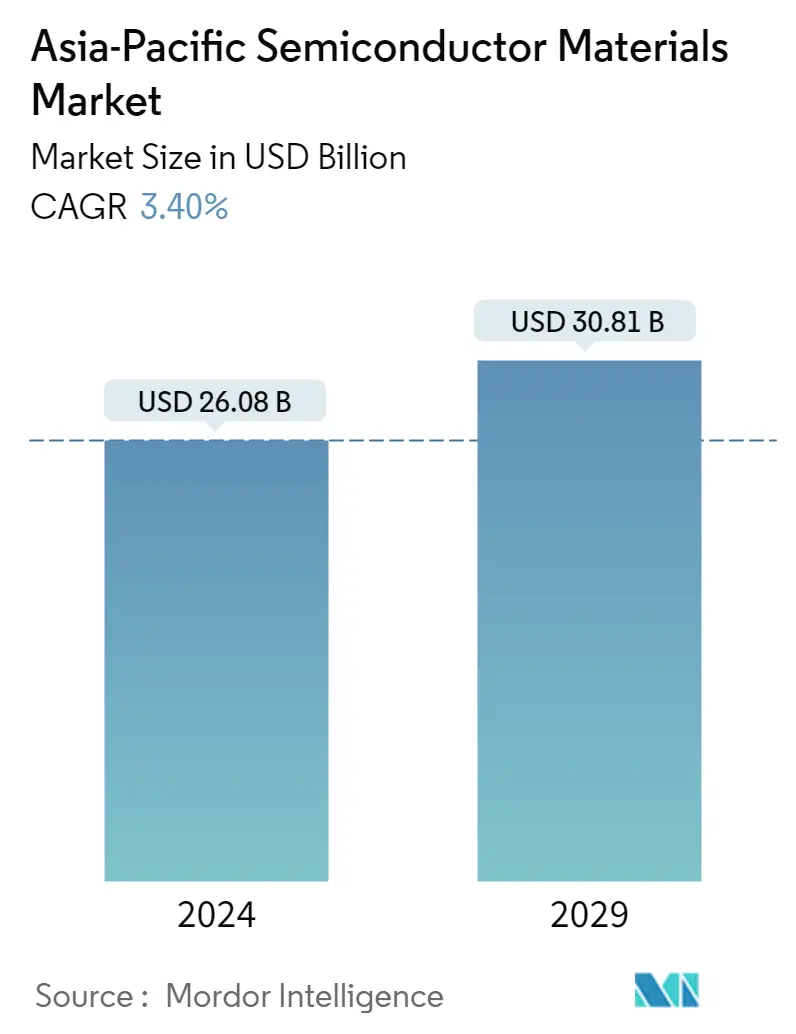
| Study Period | 2019 - 2029 |
| Base Year For Estimation | 2023 |
| Market Size (2024) | USD 26.08 Billion |
| Market Size (2029) | USD 30.81 Billion |
| CAGR (2024 - 2029) | 3.40 % |
| Market Concentration | High |
Major Players*Disclaimer: Major Players sorted in no particular order |
APAC Semiconductor Materials Market Analysis
The Asia-Pacific Semiconductor Materials Market size is estimated at USD 26.08 billion in 2024, and is expected to reach USD 30.81 billion by 2029, growing at a CAGR of 3.40% during the forecast period (2024-2029).
This may be attributed to its high electron mobility, wide temperature range, and low energy consumption. Further, the technical development of electronic devices and the rising need for semiconductor packing materials are expected to drive market growth.
- By utilizing materials such as silicon (Si), germanium (Ge), and gallium arsenide (GaAs), electronics manufacturers have been able to replace traditional thermionic devices that made electronic items heavy and non-portable. Since the inception of semiconductor elements, there has been a high degree of miniaturization, making electronic equipment more compact and mobile. Silicon is considered the best among all the semiconductor elements available in the current market scenario.
- The semiconductor industry is dominated by a few countries, mainly the U.S., Taiwan, South Korea, Japan, China, and Europe. As per SIA (U.S. Semiconductor Industry Association), 57% of the semiconductor materials, 56% of wafer fabrications, and 70% of the memory come from Asian countries. China has been investing strategically to strengthen its semiconductor industry and has been able to maintain strong supply chain control. Such factors increase the demand for semiconductor materials in the region.
- The spike in demand for consumer electronics is one of the primary reasons driving the growth of the worldwide semiconductor materials market. Furthermore, technological developments and the adoption of novel technologies such as artificial intelligence and blockchain propel the semiconductor market forward.
- According to the India Electronics and Semiconductor Association, India is anticipated to consume around USD 27 billion worth of semiconductors in 2022 and USD 70 billion by 2026. The semiconductor market will also see an increase in demand; as 5G connections are implemented and used, the performance of 5G will directly improve the production of smart products. Furthermore, Internet of Things (IoT) devices may support multiple connections simultaneously while increasing speed, latency, reliability, and battery consumption.
- The semiconductor materials market is witnessing challenges such as the costs involved in maintaining optimized levels of physical, electrical, and thermal constraints, which is difficult. Moreover, recycling smaller semiconductor materials is financially problematic, given the small amount of material reclaimed from individual products, such as smartphones.
- The COVID-19 pandemic has halted the manufacturing of several items in the semiconductor production equipment industry, owing to lockdown across the region. Lockdown measures resulted into supply chain disruption and affected catering to the demand for the consumer electronic gadgets, which had a global impact on the semiconductor sector.
APAC Semiconductor Materials Market Trends
Silicon Segment to Witness Significant Growth
- Modern electronic devices are manufactured with resistors, diodes, transistors, and integrated circuits made of semiconductor materials. Silicon is one of the most used semiconductors in power electronic components such as diodes, thyristors, IGBT, and MOSFET transistors, among others. Semiconductor materials such as Silicon can conduct electricity at high temperatures, unlike metals, which lose their electrical charge with heat.
- The major advantages of semiconductors based on Silicon are a long life cycle, smaller volume, lightweight, simple production, great mechanical strength, lower supplying power, and economical production. Also, the physical properties of Silicon contribute to its popularity and usage as a semiconductor material.
- The Ministry of Electronics and Information Technology of India, in January 2022, approved a comprehensive program for developing a sustainable semiconductor and display ecosystem in the country at INR 76,000 (~USD 935.5). The program aims to provide attractive incentive support to companies/consortia engaged in Silicon Semiconductor Fabs, Display Fabs, Compound Semiconductors / Silicon Photonics / Sensors (including MEMS) Fabs, Semiconductor Packaging (ATMP / OSAT), and Semiconductor Design.
- In addition, Silicon materials used in 5G, beyond 5G, and electronic vehicles might meet the demand for emerging technologies. WideBandgap (WBG) power semiconductors, such as gallium nitride (GaN) and silicon carbide (SiC), with higher breakdown fields, thermal conductivity, and electron saturation velocities than silicon, are expected to become major materials for the next generation of power electronic devices.
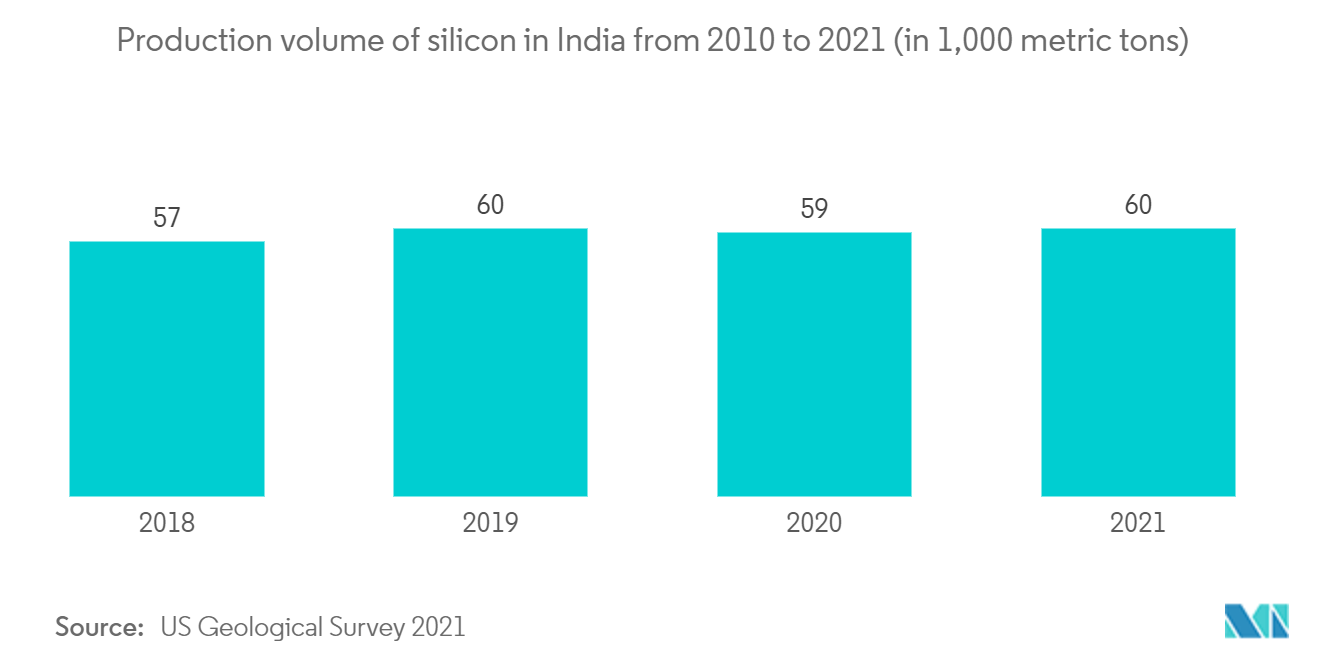
Consumer Electronics to Grow at a Considerable Pace
- The increasing popularity and affordability of consumer electronics are influencing the growth of semiconductor materials. Consumer electronics such as laptops, tablets, mobile phones, and smartwatches require complex implementations of semiconductor materials, driving the market growth of the consumer electronics segment.
- According to Asia Times in March 2022, Japan's New Energy and Industrial Technology Development Organization (NEDO) has launched a project aimed at reducing energy losses in power management devices by 50% by 2030 and reducing the cost of mass production of silicon carbide (SiC) power semiconductors. It also plans to develop advanced gallium nitride (GaN) devices.
- Furthermore, according to the Ministry of Electronics, in April 2022, India will require approximately USD 70-80 billion in semiconductors in order to manufacture electronics valued at USD 300 billion by 2026. Moreover, the government plans to achieve the goal of setting a semiconductor ecosystem in India based on demand across the globe.
- Considering the growing demand for power devices across various sectors, mainly in consumer electronics, the vendors operating in the market are increasingly focusing on new product development. For instance, recently, Lam Research Corp. announced Syndion GP, a new product that, according to the company, provides deep Silicon capabilities to chipmakers developing next-generation power devices and more.
- Gallium Nitride (GaN) is a next-generation semiconductor material with characteristics that make it ideal to use in the devices used to charge mobile devices and other consumer electronics. The material delivers efficient AC/DC power conversion compared to traditional silicon devices, reducing wasted energy during charging, and decreasing life cycle environmental impacts. This is driving the demand for semiconductor materials in the consumer electronics industry.
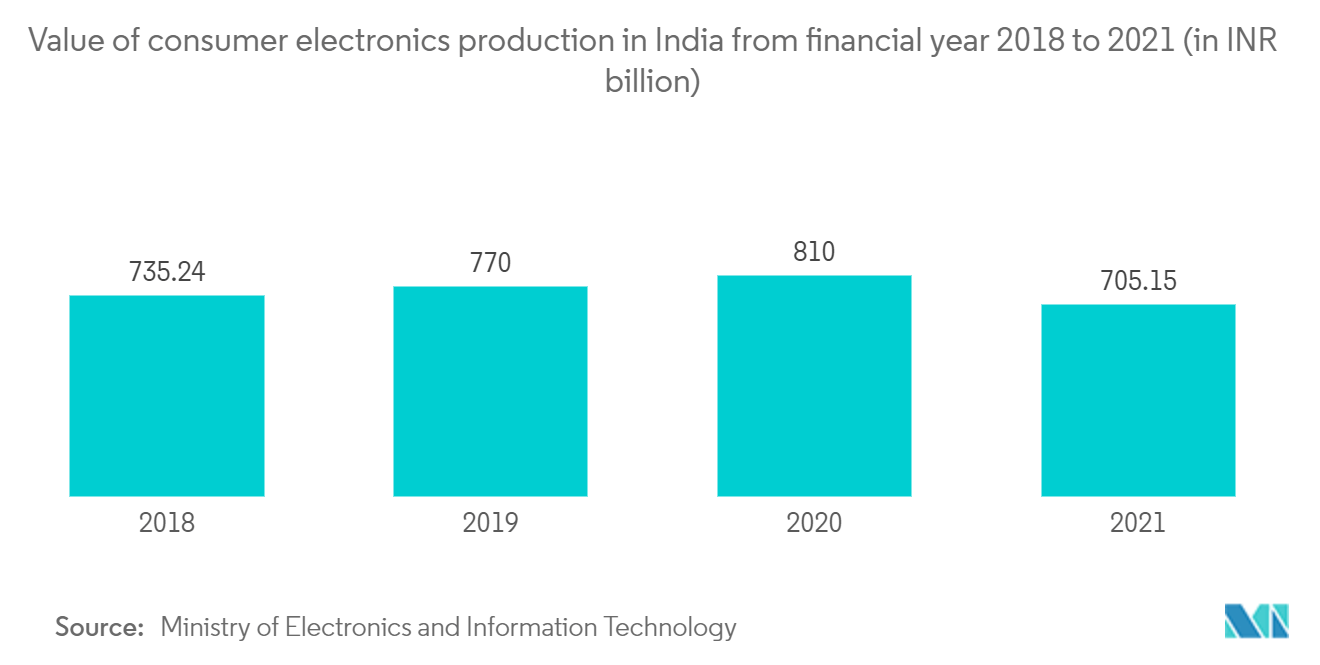
APAC Semiconductor Materials Industry Overview
The Asia-Pacific Semiconductor Materials Market is competitive with the presence of major players such as Showa Denko Materials Co. Ltd, LG Chem, Kyocera Corporation, and more. These players focus on innovating new products and technologies as part of business expansions. The companies are also focused on mergers and acquisitions to reach the customer base across the globe.
- October 2021: Kyocera Corporation was expanding its Kokubu Plant Campus in Kagoshima, Japan, to add two new production facilities to serve clients worldwide. The additional facilities will double the campus' production capacity for ceramic components used in semiconductor fabrication equipment while also securing a room for other manufacturing.
- July 2021: Showa Denko Materials Co. announced that it would increase production capacity for semiconductor materials at its subsidiary in Taiwan to meet the strong demand for the products. The subsidiary, Showa Denko Semiconductor Materials (Taiwan) Co., will boost its production capacity for chemical mechanical planarization, or CMP, slurry, a polishing material for semiconductor devices, and prepreg, one of the main materials used in multilayer printed circuit boards.
APAC Semiconductor Materials Market Leaders
-
LG Chem Ltd
-
Showa Denko Materials Co., Ltd.
-
Sumitomo Chemical Co., Ltd.
-
Kyocera Corporation
-
Intel Corporation
*Disclaimer: Major Players sorted in no particular order
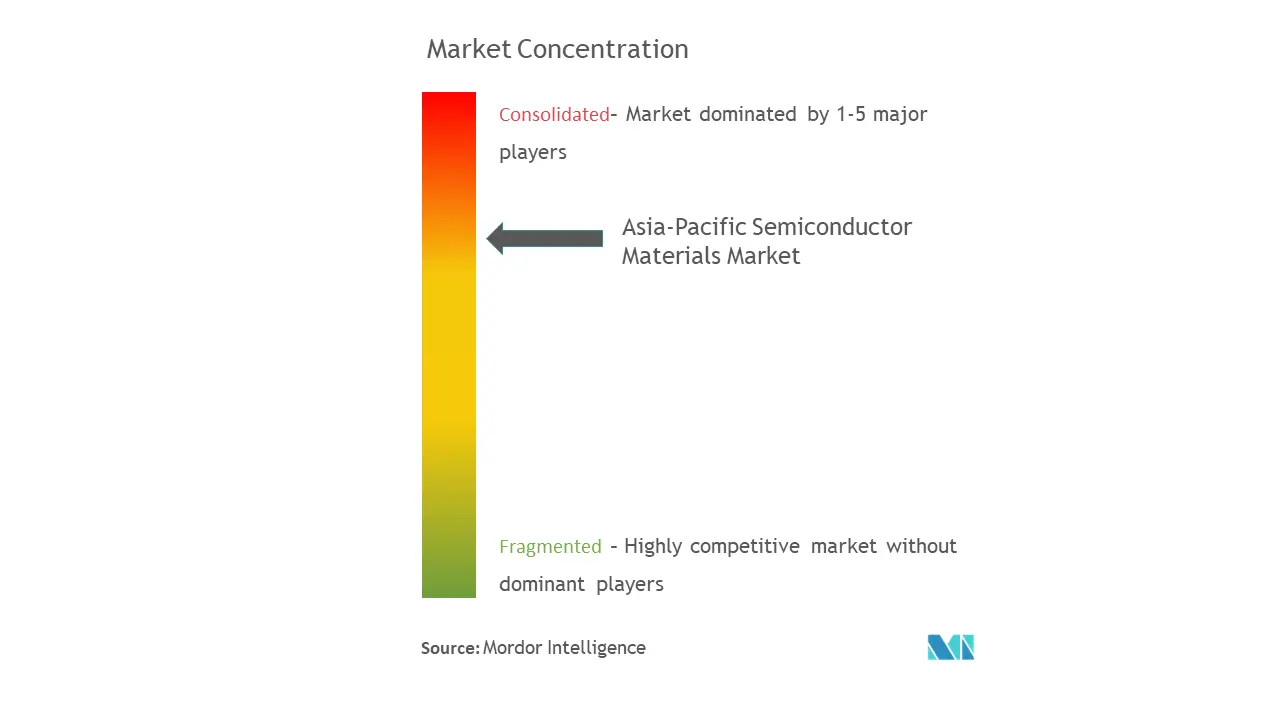
APAC Semiconductor Materials Market News
- December 2021: Intel Corporation announced that it would open a semiconductor manufacturing facility in India. The announcement by the company comes after Union Cabinet's recent decision on semiconductors, which will support research and innovation in the industry and enhance production, bolstering the 'Aatmanirbhar Bharat' program.
- August 2021: Sumitomo Chemical decided to expand its production capacity for high-purity chemicals for semiconductors. The company to install new production lines to double the capability for high-purity sulfuric acid at its Ehime Works (Niihama city, Ehime, Japan) and improve the capacity for high-purity ammonia water at the Iksan Plant of Dongwoo Fine-Chem Co., Ltd., a wholly-owned subsidiary in South Korea. The new production lines are expected to commence operation in the first half of fiscal 2024 for Ehime Works and the second half of fiscal 2023 for the Iksan Plant.
APAC Semiconductor Materials Market Report - Table of Contents
1. INTRODUCTION
- 1.1 Study Assumptions and Market Definition
- 1.2 Scope of the Study
2. RESEARCH METHODOLOGY
3. EXECUTIVE SUMMARY
4. MARKET INSIGHTS
- 4.1 Market Overview
-
4.2 Industry Attractiveness - Porter's Five Forces Analysis
- 4.2.1 Bargaining Power of Suppliers
- 4.2.2 Bargaining Power of Consumers
- 4.2.3 Threat of New Entrants
- 4.2.4 Intensity of Competitive Rivalry
- 4.2.5 Threat of Substitute Products
- 4.3 Assessment of COVID-19 Impact on the Market
5. MARKET DYNAMICS
-
5.1 Market Drivers
- 5.1.1 Technological Progress and Product Innovation in Electronic Materials
- 5.1.2 Increased Demand for Consumer Electronics
-
5.2 Market Restraints
- 5.2.1 Complexity of the Manufacturing Process
6. TECHNOLOGY SNAPSHOT
7. MARKET SEGMENTATION
-
7.1 By Material
- 7.1.1 Silicon Carbide (SiC)
- 7.1.2 Gallium Manganese Arsenide (GaAs)
- 7.1.3 Copper Indium Gallium Selenide (CIGS)
- 7.1.4 Molybdenum Disulfide (MoS)
- 7.1.5 Bismuth Telluride (Bi2Te3)
-
7.2 By Application
- 7.2.1 Fabrication
- 7.2.1.1 Process Chemicals
- 7.2.1.2 Photomasks
- 7.2.1.3 Electronic Gases
- 7.2.1.4 Photoresists Ancilliaries
- 7.2.1.5 Sputtering Targets
- 7.2.1.6 Silicon
- 7.2.1.7 Other Fabrication Materials
- 7.2.2 Packaging
- 7.2.2.1 Substrates
- 7.2.2.2 Lead Frames
- 7.2.2.3 Ceramic Packages
- 7.2.2.4 Bonding Wire
- 7.2.2.5 Encapsulation Resins (Liquid)
- 7.2.2.6 Die Attach Materials
- 7.2.2.7 Other Packaging Materials
-
7.3 By End-user Industry
- 7.3.1 Consumer Electronics
- 7.3.2 Telecommunication
- 7.3.3 Manufacturing
- 7.3.4 Automotive
- 7.3.5 Energy and Utility
- 7.3.6 Other End-User Industries
-
7.4 By Country
- 7.4.1 Taiwan
- 7.4.2 South Korea
- 7.4.3 China
- 7.4.4 Japan
- 7.4.5 Rest of Asia-Pacific
8. COMPETITIVE LANDSCAPE
-
8.1 Company Profiles
- 8.1.1 BASF SE
- 8.1.2 LG Chem Ltd
- 8.1.3 Indium Corporation
- 8.1.4 Showa Denko Materials Co. Ltd
- 8.1.5 Kyocera Corporation
- 8.1.6 Henkel AG & Company KGAA
- 8.1.7 Sumitomo Chemical Co. Ltd
- 8.1.8 Dow Chemical Co.
- 8.1.9 Intel Corporation
- 8.1.10 UTAC Holdings Ltd
- *List Not Exhaustive
9. INVESTMENT ANALYSIS
10. FUTURE OF THE MARKET
** Subject To AvailablityAPAC Semiconductor Materials Industry Segmentation
The Asia-Pacific semiconductor materials market is segmented by type of material (silicon carbide, gallium manganese arsenide, copper indium gallium selenide, molybdenum disulfide, and bismuth telluride), application (fabrication (process chemicals, photomasks, electronic gases, photoresists ancillaries, sputtering targets, silicon, and other fabrication materials)), packaging (substrates, lead frames, ceramic packages, bonding wire, encapsulation resins, die attach materials, and other packaging types), end-user industry (consumer electronics, telecommunication, manufacturing, automotive, energy and utility, and other end-user industries) and geography (Taiwan, South Korea, China, Japan, and Rest of Asia-Pacific). The market sizes and forecasts are provided in terms of value (USD million) for all the above segments.
| By Material | Silicon Carbide (SiC) | |
| Gallium Manganese Arsenide (GaAs) | ||
| Copper Indium Gallium Selenide (CIGS) | ||
| Molybdenum Disulfide (MoS) | ||
| Bismuth Telluride (Bi2Te3) | ||
| By Application | Fabrication | Process Chemicals |
| Photomasks | ||
| Electronic Gases | ||
| Photoresists Ancilliaries | ||
| Sputtering Targets | ||
| Silicon | ||
| Other Fabrication Materials | ||
| By Application | Packaging | Substrates |
| Lead Frames | ||
| Ceramic Packages | ||
| Bonding Wire | ||
| Encapsulation Resins (Liquid) | ||
| Die Attach Materials | ||
| Other Packaging Materials | ||
| By End-user Industry | Consumer Electronics | |
| Telecommunication | ||
| Manufacturing | ||
| Automotive | ||
| Energy and Utility | ||
| Other End-User Industries | ||
| By Country | Taiwan | |
| South Korea | ||
| China | ||
| Japan | ||
| Rest of Asia-Pacific |
APAC Semiconductor Materials Market Research FAQs
How big is the Asia-Pacific Semiconductor Materials Market?
The Asia-Pacific Semiconductor Materials Market size is expected to reach USD 26.08 billion in 2024 and grow at a CAGR of 3.40% to reach USD 30.81 billion by 2029.
What is the current Asia-Pacific Semiconductor Materials Market size?
In 2024, the Asia-Pacific Semiconductor Materials Market size is expected to reach USD 26.08 billion.
Who are the key players in Asia-Pacific Semiconductor Materials Market?
LG Chem Ltd, Showa Denko Materials Co., Ltd., Sumitomo Chemical Co., Ltd., Kyocera Corporation and Intel Corporation are the major companies operating in the Asia-Pacific Semiconductor Materials Market.
What years does this Asia-Pacific Semiconductor Materials Market cover, and what was the market size in 2023?
In 2023, the Asia-Pacific Semiconductor Materials Market size was estimated at USD 25.22 billion. The report covers the Asia-Pacific Semiconductor Materials Market historical market size for years: 2019, 2020, 2021, 2022 and 2023. The report also forecasts the Asia-Pacific Semiconductor Materials Market size for years: 2024, 2025, 2026, 2027, 2028 and 2029.
Asia-Pacific Semiconductor Materials Industry Report
Statistics for the 2024 Asia-Pacific Semiconductor Materials market share, size and revenue growth rate, created by Mordor Intelligence™ Industry Reports. Asia-Pacific Semiconductor Materials analysis includes a market forecast outlook to 2029 and historical overview. Get a sample of this industry analysis as a free report PDF download.

